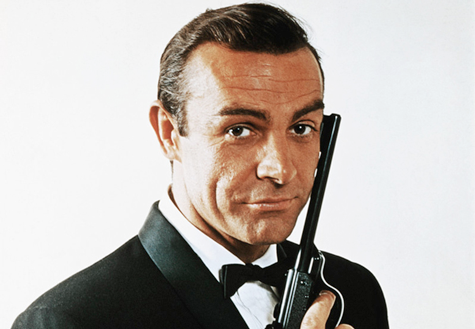
It’s the 1960’s, and as the James Bond franchise is in the midst of exploding onto the scene, the author and creator of 007, Ian Fleming, dies on August 12, 1964. While Goldfinger (1964), the third Bond film drawn from Fleming’s novels about the British secret agent with a license to kill, would be released a month after his death, the eventual billion-dollar film franchise never looked back.
However, despite the success of the films, the thirst of the reading public still needed to be slaked. So, after two posthumous, Fleming-authored books were exhausted, his estate turned to what some considered an unlikely source to carry on Bond’s exploits: Kingsley Amis, writing as Robert Markham. Glidrose Productions (who held the rights to the novels) had the goal of switching out various authors under the “Markham” nom de plume.
Although Amis’s own literary output inclined toward comedic prose with a biting sarcastic edge—his most renowned work being Lucky Jim (1954), a story about a college lecturer who rebels against the stiff academic world—he was an acknowledged Bond admirer, having authored two non-fiction books on the subject in 1965 (The James Bond Dossier and The Book of Bond, or Every Man His Own 007).
Early criticism of the selection of Amis to continue the 007 series came from a particularly damning source: Fleming’s widow, Anne. She had harshly sniped:
Amis will slip Lucky Jim into Bond’s clothing, we shall have a petit-bourgeois red-brick Bond, he will resent the authority of M., then the discipline of the Secret Service, and end as Philby Bond selling his country to SPECTRE.
She was—to borrow British slang—bloody wrong. After the somewhat sketchy release of The Man With The Golden Gun (1965), Amis was able to bring the series back onto firm footing with Colonel Sun (1968), a character-driven plot topped with adrenaline-pumping action.
The story unfolds as Bond arrives to visit a bedridden M, his boss, who is recovering from an illness. However, assassins have already killed M’s household staff, and are in the process of kidnapping the head of the secret service himself. Agent 007 manages to eliminate one of the bad guys before being stuck with a needle, and then escapes the subsequent dragnet by crashing through a top-floor window of the residence. After recovering from the drug-infused injection, Bond follows clues that were planted on the deceased assassin, leading him to the Greek island of Vrakonisu.
There, he finds Colonel Sun, a member of the Chinese People’s Liberation Army, and discovers his plans to start the next World War by attacking a Middle East conference. The conniving Colonel further plans to blame the British by dumping the remains of M and Bond at the site of the attack. Aiding Sun in his mission is Ariadne Alexandrou, an idealistic Greek Communist working for the Soviets, who initially is supposed to lead Bond to his capture. However, when Sun’s operatives execute her cohorts, she joins forces with Bond to destroy Colonel Sun.
Fans who want gadgetry in every other chapter will likely be disappointed, but only because Amis builds suspense in the good, old-fashioned way—on a well-constructed plot that’s brimming with Cold War tension and peppered by snappy dialogue. It’s a shame Amis didn’t write more Bond novels; he had a penchant for its style and seemed like a natural.
Amis was asked about his preference for genre fiction in a 1975 interview for The Paris Review, and after making reference to several suspense writers, including Eric Ambler, Amis replied:
Well, I start from the same place as the genre writers start from: they cannot afford to bore me, and I cannot stand being bored, so we begin at the same place. And they have all sorts of things forced on them: some sort of pace, a feeling of conflict, climaxes, anticlimaxes, suspense, and so on. They have to do that. And having done that, they can then erect other matters.
Colonel Sun doesn’t bore and was a financial success. Still, mysteriously, the novel fell into a long spell of inactivity, remaining unpublished in paperback until 1991 and only released in e-book form as recently as 2012. Allegedly, Anne Fleming had no interest at all in anyone succeeding her husband, and it wasn’t until 1981—the year of her own passing—that a full-blown continuation of 007 blossomed with John Garner filling the authorial duties for Licensed Renewed.
 Due to the out-of-print status, the unknown Markham penname, and that beautifully, bizarre cover (a Dali-like impressionistic painting), Colonel Sun fell by the wayside. But now, it’s time to recognize this Amis entry as one of the finest in the illustrious Bond series.
Due to the out-of-print status, the unknown Markham penname, and that beautifully, bizarre cover (a Dali-like impressionistic painting), Colonel Sun fell by the wayside. But now, it’s time to recognize this Amis entry as one of the finest in the illustrious Bond series.
David Cranmer aka Edward A. Grainger is the publisher and editor of BEAT to a PULP books http://www.beattoapulp.com/ and writer of the forthcoming The Drifter Detective #7: Torn and Frayed. He lives in New York with his wife and daughter.

Excellent article on a good book. Amis was co-author of The Man with the Golden Gun, apparently, after Fleming’s death, so he had a ‘feel’ for the character, and I agree it was a shame he couldn’t write other adventures. In the latest Bond film SPECTRE there are echoes of Colonel Sun in the torture scene near the end… I’d also recommend Amis’s THE ALTRATION, an alternate history novel (Amis was also a fan of science fiction).
I read this one, with the weird cover in hardback probably in the early 80s. I feel like it said it was by Kingsley Amis, though — were there later reprintings that referenced that?